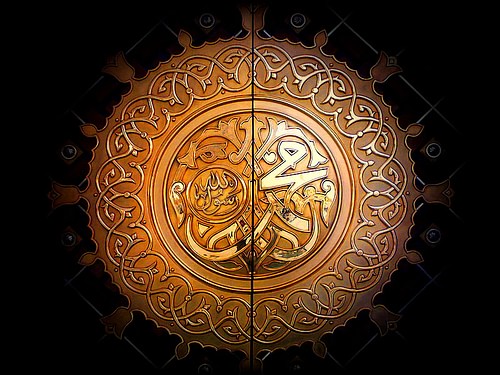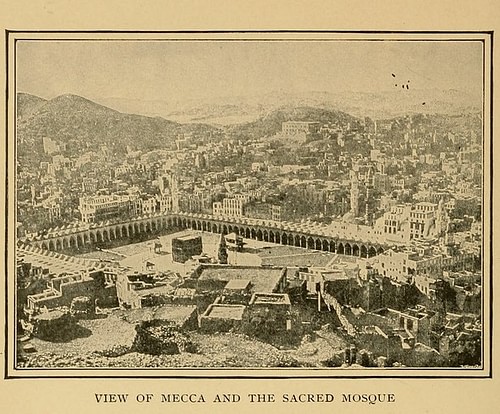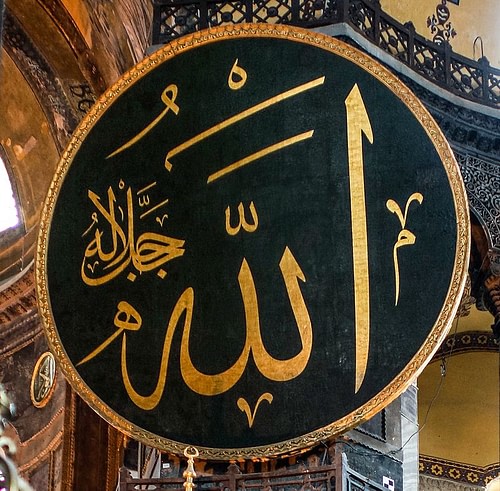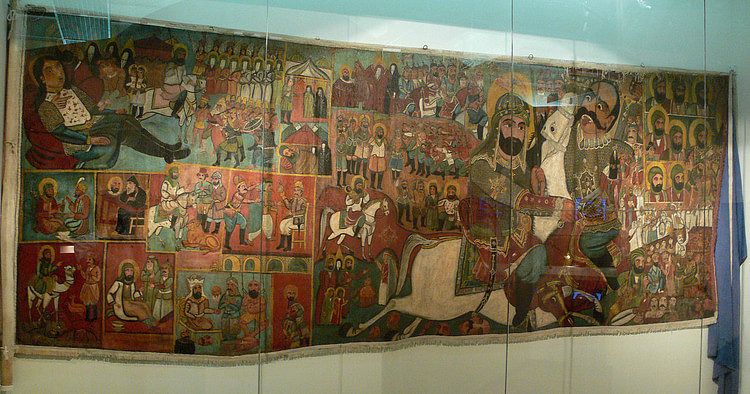
Islam is an Abrahamic-monotheistic religion based upon the teachings of Prophet Muhammad ibn Abdullah (l. 570-632 CE, after whose name Muslims traditionally add “peace be upon him” or, in writing, PBUH). Alongside Christianity and Judaism, it is a continuation of the teachings of Abraham (featured in both Jewish and Christian scriptures, considered a prophet in Islam, after whose name Muslims say, “peace be upon him” as well), although it does differ in some respects from both of these. The adherents of Islam are referred to as Muslims, of which there are around two billion in the world today, second only to Christians in number.
Taking roots from humble beginnings in the Arabian Peninsula, the followers of Muhammad managed to conquer the superpowers of the time: the Sassanian Empire and the Byzantine Empire. At its peak (750 CE), the Islamic Empire stretched all the way between parts of modern-day Pakistan in the east and to Morocco and the Iberian Peninsula in the west. Although initially spread by conquest, Islam would later flourish through trade to expand beyond its initial borders and around the world. In the present day, it is the world's fastest-growing religion.
The Prophet's Mission
The Prophet – Muhammad ibn Abdullah – was born in 570 CE. He was a member of the Qurayshite clan of Banu Hashim, a highly respected faction despite their declining wealth. Orphaned at an early age, he was raised by his uncle Abu Talib, who is said to have loved him even more than his own sons. Muhammad became a trader and was renowned for his honesty (as it was a rare trait in Arabia in those days), and this honesty attracted the attention of a wealthy widow named Khadija who sent a marriage proposal, which he accepted, although she was 15 years older than him (he was 25 years of age at the time). Khadija's support for Muhammad was instrumental in the Prophet pursuing his mission.
As he reached his late thirties, he began worshipping in seclusion, in a cave called Hira, in the mountain Jabal al-Nour (“Mountain of Light”), near Mecca. One day in 610 CE, the Angel Gabriel is said to have approached him with the first revelation from God – Allah (meaning “the God”). Muhammad is said to have initially reacted negatively to the revelation – he was perplexed and scared, he ran back home, shivering with fear – but later on he realized that he was a prophet of God.
Muhammad began preaching the oneness of God to his family and close friends, and afterwards, to the general public. Arabia was polytheistic at the time and so Muhammad's preaching of a single god brought him into conflict with the Meccans whose economy relied on polytheism (merchants sold statues, figurines, and charms of the various gods) and the social stratification it supported. The Meccans took serious measures to stop him but he continued to preach this new faith as he felt he owed it to God to do so. In the year 619 CE, he lost both his uncle Abu Talib and his wife Khadija (a date known to Muslims as The Year of Sorrow) and now he felt alone in the world and sorely grieved, a situation worsened by the persecution he experienced in Mecca.

With their newfound base, the Muslims now wanted to strike back against those who had persecuted them. The Muslims started conducting regular raids or “Razzias” on Meccan trade caravans. These raids were technically an act of war; the Meccan economy suffered and now they were angered and decided to end the Muslims once and for all. The Muslims faced an attack from the Meccans at the Battle of Badr (624 CE) where 313 Muslim troops routed an army of around 1,000 Meccans; some credit this victory to divine intervention while others to Muhammad's military genius.
After the victory at Badr, the Muslims became more than just a group of followers of a new religion, they became a military force to be reckoned with. Multiple engagements followed between the Muslims and other Arabian tribes, with a great deal of success for the Muslims. In the year 630 CE the doors of Mecca, the city from which they had fled in panic a decade earlier, were opened to the Muslim army. Mecca was now in Muslim hands and, against all expectations, Muhammad offered amnesty to all those who surrendered and accepted his faith.

By the time of his death in 632 CE, Muhammad was the most powerful religious and political leader in all of Arabia. Most of the tribes had converted to Islam and swore their allegiance to him. He died in his own house, in Medina, and was buried there as well. The site has now been converted to a tomb named “Roza – e – Rasool” (Tomb of the Prophet), which lies adjacent to the famous “Masjid al-Nabwi” (Mosque of the Prophet) in Medina and is visited by millions of Muslims every year. In his book, A History of Medieval Islam, scholar J. J. Saunders comments on the Prophet of Islam:
His piety was sincere and unaffected, and his honest belief in the reality of his call can be denied only by those who are prepared to assert that a conscious imposter endured for ten or twelve years ridicule, abuse and privation, gained the confidence and affection of upright and intelligent men, and has since been revered by millions as the principle vehicle of God's revelation to man. (34)
The revelations which are said to have been given to Muhammad by the angel Gabriel were memorized by his followers and, within a few years after his death, were written down as the Quran (“the teaching” or “the recitation”), the holy book of Islam.
Quran, Sunna, & Hadith
According to Muslims, the verses of the Quran, as dictated by the angel to Muhammad, are the words of God and the final revelation of divine truth to humanity. After Muhammad's death, these revelations were compiled in the form of a book by his father-in-law Abu Bakr (r. 632- 634 CE as the first caliph – the successor of the Prophet's mission and empire) so as to preserve them for future generations. In the life of the Prophet, these revelations were written individually on parchment or other materials, and these isolated revelations were later arranged in the sequence dictated by the Prophet to form the Quran. Muslims would memorize the verses and recite them (hence one of the translations of Quran is “the recitation”). Later it was noted that different Muslims were reciting the verses in different dialects and so a standardization project was undertaken to preserve the words of the Prophet's message.
Extreme care was made to prevent any tampering of the text. This task was started reluctantly by the immediate successor of Muhammad's empire – Caliph Abu Bakr (who was afraid to do something the Prophet had not done) and was finalized in the reign of the third caliph – Uthman ibn Affan (r. 644- 656 CE). To Muslims, the Quran can only be properly understood when read – or heard – in the original language. Although accurate translations are regarded as acceptable by certain sects, adherents are still encouraged to learn the Quran in the original.
After the Quran, an important source of guidance for the Muslims is the life of the Prophet: his ways (Sunna) and his sayings (Hadith); both of these act as a supplement to the text of the Quran. The Quran is considered the Word of God, as earlier noted, but Muslims also find reassurance and guidance in learning how Muhammad would have behaved in certain situations and, for this, the Sunna and Hadith are important.
For example, the Quran emphasizes time and again to “establish prayer and pay the alms”, but one might wonder how? The answer to how is in the Sunna and Hadith which make clear that one is to simply do it the way the Prophet did and act as the Prophet instructed. In fact, in many instances, the Quran states: “Obey Allah (God) and obey his Prophet” (which emphasizes the importance of Sunna and Hadith). Hadith, just like the Quranic verses, have been compiled but have been kept separate from the Quran, once again to prevent any sort of tampering of the divine revelations. Scholar Tamara Sonn explains the importance of these elements in her book Islam – A Brief History:
As the word of God, it (Quran) is co-eternal with God… The overall audience for the scripture is humanity as a whole… Muslims believe that the Quran reiterates, confirms, and completes these earlier (Torah, Psalms and Gospel) scriptures, calling upon all people to remember and respect the truths carried in them… Together, the Quran and the example (called the Sunna) set by Prophet Muhammad comprise the guidance Muslims need in their collective responsibility to establish justice. (lines cited from p.2 and following)
The Quran, then, provides followers with the Word of God while the Sunna and Hadith give guidance on how one observes that word and includes its precepts in one's daily life.

Pillars of Islam
The acts of worship in Islam, or the “pillars” on which the foundation of Islam rests, are the formal duties that all people who choose Islam as their path must acknowledge and adhere to. The Five Pillars of Islam are:
- Shahada (testimony)
- Salat (prayer five times a day)
- Zakat (alms/tax paid to help others)
- Sawm (fasting during the time of Ramadan)
- Hajj (pilgrimage to Mecca at least once in a lifetime)
The first pillar – Shahada – is essential for anyone to become a Muslim; it is the acknowledgment of oneness of Allah (God) in all attributes and is commonly expressed in the phrase: “There is no one worthy of worship but Allah (God) and Muhammad is Allah's Prophet.”
The concept of God in Islam dictates that he is beyond all imaginations (the pronoun “he” is merely a convenience for our use, in no way does it dictate any of his attributes) and the most supreme; his is whatever is in the universe, and everything submits to his will; so, therefore, must human beings in order to live in peace. In fact, the word “Islam” literally means “submission” as in submission to the will of God.

The second pillar is the daily prayer – Salah – which has to be offered five times a day. Males are required to offer these prayers in congregation in special Muslim worship places called Masjid (mosques) while women can pray at home. The basic design of mosques varies from place to place and, in most cases, many elements of local architecture have been inculcated in them (i.e. the Blue Mosque of Istanbul draws on many architectural features of the famous cathedral Hagia Sophia). The areas of a mosque are divided between male and female worshippers and the imam who leads the worship service.
The third pillar – Zakat – is the giving of alms which must be paid by all eligible people (individuals who own a certain amount of wealth which is not currently in their use) once every year to fellow underprivileged Muslims (although other acts of charity are also applicable for non-Muslims, the zakat is reserved for Muslims). Non-Muslims (known as dhimmi – protected people) were long required to participate through the tax known as jizya, although this policy has been abolished in many Muslim countries since the early 20th century CE.

The fourth pillar – Sawm – is fasting during the Islamic month of Ramadan (the ninth month of the Islamic calendar). During the period of fasting, a believer must abstain from eating, drinking and all worldly pleasures and devote time and attention to God. Ramadan encourages believers to draw closer to God and examine their priorities and values in life; depriving one's self of food and other distractions is thought to focus one's attention completely on the divine.
The fifth pillar – Hajj – is the annual pilgrimage to the Ka'aba, the Qiblah of the Muslims (the direction in which they pray – a sign of unity) in Mecca. The Hajj is only compulsory once in a person's lifetime and only if one can afford it and has the strength to make the journey. If one cannot go, one must at least express the sincere desire to do so and, if possible, contribute to someone else's pilgrimage.
Spread of Islam
Mecca, as noted, was originally the city that rejected Muhammad and his message but, later, became the heartland of the faith (as it houses the Ka'aba), while Medina, the city that welcomed the Prophet when none else did, became the capital of the empire. Arabia was located at the crossroads of the Persian Sassanian Empire (224-651 CE) and the Byzantine Empire (330-1453 CE). As these two superpowers were almost constantly at war, in time, the people of Arabia suffered from the disruption of the region around them and, once united under Islam, launched a full-scale invasion into both of these empires to facilitate a rapid expansion of Islam. Scholar Robin Doak explains in his book Empire of the Islamic World:
The Byzantines had competition for control of the Middle East. The Sassanian, or Persian, Empire dominated areas to the southeast of Byzantium (modern-day Istanbul) … These two empires were constantly at war with one another… To pay for these wars, both empires placed heavy taxes on the citizens under their control. These taxes, along with other restrictions, caused unrest in Sassanian and Byzantine lands, especially among the Arab tribes living on the fringes of the two empires. (6)
The Arabs were originally tribal in nature and lacked unity. These tribes needed to be united in the interests of stability, and Islam became the means of binding them together. After the death of Prophet Muhammad in 632 CE, the leadership of the Muslim Ummah (community) was taken by Abu Bakr, who assumed the title of caliph (successor of the Prophet). In his brief reign of two years (632-634 CE), he united all of the Arabian Peninsula under the banner of Islam (as most of the tribes had forsaken the community) and then sent armies to expand his dominion over other Arabian tribes who lived under Byzantine and Sassanian rule. These campaigns turned out to be so swift and successful that by the time of the third caliph, Uthman, the whole of Egypt, Syria, Levant, and what was once the major part of the Sassanian Persian Empire now rested in Muslim hands, and all attempts to regain lost territory were beaten back with the help of the locals who had mostly accepted Muslim rule.
The fourth and last of the early, “rightly guided caliphs” (as the first four are referred to by Sunni Muslims), was Ali ibn Abi Talib (r. 656-661 CE). Ali spent most of his tenure in constant civil strife and expansion was halted. After Ali's death in 661 CE, he was succeeded by Mu'awiya I (r. 661-680 CE) who founded the Umayyad Dynasty. Mu'awiya I declared his son, Yazid I (r. 680-683 CE), his successor but this was contested by Ali's son (Muhammad's grandson) Hussayn ibn Ali (l. 626-680 CE). Hussayn's feeble force was defeated at the Battle of Karbala in 680 CE by Yazid's troops, where he was also killed, other uprisings were also crushed one by one and later caliphs of the Umayyad Dynasty then continued military expansion.

By the end of the Umayyad Dynasty (750 CE), Transoxiana, parts of modern-day Pakistan, the entirety of North Africa, and the Iberian Peninsula (also known as Al Andalus – the land of the Vandals) had been added to the empire. During the rule of the Abbasids (750-1258 CE), some minor territorial gains were made but the trend of earlier swift conquests through military raids was over. This trend was revived by the Ottoman Sultanate (1299-1922 CE), which later assumed the title of Caliphate of the Islamic World.
Anatolia and the heart of the Byzantine Empire – Constantinople – was conquered by the Ottomans in 1453 CE who then closed the trade routes known as the Silk Road (which they had come to control), forcing European nations to seek other sources for the goods they had grown used to and launching the so-called Age of Discovery which saw European nations sending ships around the globe, “discovering” the so-called New World. According to some scholars, however, the New World had already been reached by the Chinese Muslim explorer Zheng-He (l. 1371-1435 CE) in 1421 CE (although this claim has been repeatedly challenged). The Age of Discovery (also known as the Age of Exploration) opened up the world, for better and worse, bringing peoples of diverse cultures into contact with each other on a greater scale than before.
The military conquests of the Ottomans allowed expansion of the Islamic Empire, but the faith itself was spread as much by trade, at this point, as by conquest, as pointed out by Ruthven and Nanji in The Historical Atlas of Islam:
Islam expanded by conquest and conversion. Although it was sometimes said that the faith of Islam was spread by the sword, the two are not the same. The Koran (archaic spelling for the Quran) states unequivocally, [in Sura 2:256], “There is no compulsion in religion”. (30)
Although the Quran has a number of verses advocating against compulsion in conversion, there is no denying that Islam was initially spread through military conquest. Most of the local populations of newly conquered lands adhered to their previous faiths, some converted out of free will but there were also several instances of forced conversions (which ironically is un-Islamic). By the time of the Ottomans, however, it was trade, primarily, which took the faith across borders as many missionaries intermingled with local and foreign populations, spreading the faith as they travelled.
Islamic Schism: Sunni & Shia
Even so, for many years prior, Islam was not a completely unified faith as far as how it was observed. After the death of Prophet Muhammad in 632 CE, his followers were confused as to who should succeed him. It was decided, shortly after Muhammad's death, that Abu Bakr should become his successor – his caliph. Another group, however, pressed that Ali, the Prophet's cousin and son in law, should be the one to succeed him. Ali's turn would indeed come as the fourth caliph but his followers – Shia't Ali (adherents of Ali) claimed that Ali was the lawful successor to Muhammad and, later, would claim that his three predecessor caliphs were usurpers; these followers of Ali are the Shia Muslims.
The majority of the Muslims, however, maintained that Abu Bakr, Umar ibn al-Khattab (r. 634-644 CE), and Uthman were just as lawful successors of Muhammad as Ali and consider them legitimate; these Muslims are known as Sunni (followers of the Sunna or the way of Muhammad). Initially, these two were merely political groups but then they evolved into religious sects.
The basic beliefs of these sects are almost identical, with the core exception being the concept of imams. Sunnis consider imams to be guides or teachers who guided the Muslims along the path of Islam (or the person who lead the congregation during prayer), the most famous one being Imam Abu Hanifa – founder of the Hanafi school of Sunni Islamic thought. On the other hand, Shias consider imams to be a connecting link between humans and God (semi-divine), and consider only the descendants of Muhammad through Ali and Fatima (Prophet's daughter), and later only the descendants of Ali (from other wives), to be worthy of this title, such as Imam Hussayn, the son of Ali, who was killed by the Umayyad army at the Battle of Karbala in 680 CE.
The loss of Hussayn is mourned by Shia Muslims at the festival of Ashura annually which is denigrated by Sunni Muslims who reject the claims of the Shia regarding the role of the imam and, although they do respect Hussayn and consider his death tragic, they do not consider him semi-divine as the Shias do.
Apart from this contention, and some other theological differences, the two sects are almost the same; even so, their adherents have been rivals for almost as long as they have existed as exemplified through the rivalry of the Sunni Abbasid Dynasty and Shia Fatimids, Sunni Ottomans and Shia Safavids, etc.
Legacy of Islam
In spite of the early use of conquest in spreading the faith, and the sectarian violence that has persisted between the Sunni and Shia, Islam has contributed greatly to world culture since its inception. The European renaissance would have never happened if the works of the classical Roman and Greek scholars had not been preserved by the Muslims. To cite only one example, Aristotle's works – so fundamental to later developments in so many disciplines – would have been lost had they not been preserved and copied by Muslim scribes. The works of the Muslim polymath Avicenna (l. c. 980-1037 CE) and the scholar Averroes (l. 1126-1198 CE) not only preserved Aristotle's work but added to it through their brilliant commentary and, further, spread Aristotelian thought through their own works. Avicenna wrote the first collective book on medicine – the Al-Qanun fi-al-Tib (Canon of Medicine) which was far more accurate than European texts on the subject at the time.
Al-Khwarizmi (l. c.780-c.850 CE), the brilliant astronomer, geographer, and mathematician, developed algebra and Al-Khazini (11th century CE) challenged and encouraged modifications to the Ptolemaic Model of the Universe. Coffee, arguably the most popular drink in the world today, was developed by Muslim Sufi monks in Yemen in the 15th century CE and was introduced to the world through the port of Mocha, Yemen (thus associating the word “mocha” with coffee).
Islamic scholars, poets, writers, and artisans have contributed to developments in virtually every area of world culture and continue to do so in the present day. It is unfortunate that, in the West, Islam today is so often associated with violence and terrorism because, at its heart, Islam is a religion of peace and understanding. Muslims around the world, one-third of the world's population, follow – or at least try to follow – the path of peace Muhammad revealed 14 centuries ago and his legacy of compassion and dedication to the divine and the greater good continues even to this day in the form of his followers.
Author's Note: Grateful acknowledgment to Joshua J. Mark for his assistance in preparing this article.









